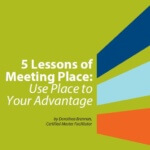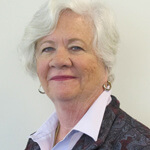By Dorothea Brennan, Certified Master Facilitator
In The Effective Facilitator principles, we know that Place is the final P of the 6 Ps of Preparation – Purpose, Product, Participants, Probable Issues, Process – and Place. While Place covers all of the logistics of a meeting, my focus here will be the physical place or the space where the facilitation will occur.
 Download the printable version here!
Download the printable version here!
Lesson #1: Most of us are unconscious of the impacts of meeting Place.
I am not sure where in my background I learned to pay so much attention to space, but it has contributed to my success as a facilitator. In the early 1980s, I was tasked to be both team leader and facilitator for a group of six high-potential middle managers. We were mostly in our 30s and tasked to work on a specific strategic planning initiative for a large commercial bank. We were using an IBM process methodology and were together for 6 weeks.
I had no control over the space assigned. It was an interior conference room, utilitarian – no windows and no attempt to make it feel open or airy. The first few days we ordered lunch to be delivered to the room. I watched as the participants started to act out. Think class clown antics – not harmful, just distracting. In short time, we realized we were claustrophobic, so we made it a rule to go out to lunch. Things improved – a little. Finally, I was able to get us moved to a conference room with windows. Even though the antics had become embedded in our team culture, they receded to early morning, breaks, and lunch. This just happened; it was not a conscious decision on our part.
Lesson #2: Place puts the “functional” in cross-functional teams.
Fast forward to 2004, I was asked to run sessions that were a combination of facilitation and training for all 800 employees of a local electric utility. This put union and management in the same room while they were still recovering from a strike. The other wrinkle was that the field workers were used to being outdoors working in crews of two, four, sometimes six. I was going to put them in a room with 20 – at a table – for two hours.
I was fortunate to have access and resources to create some swing space. I worked with a great facilities team using the following design criteria:
- Spend very little money
- Have windows and lots of light
- Give individuals a lot of personal space – line crews often work with one in the aerial bucket and one on the ground
- Have enough space so that participants could stand behind their seats (as a break from sitting), and others could still pass by comfortably
- Have room for food tables – and easy access without leaving the meeting
- Have room for a group activity where everyone needs to be around a table
Management was very concerned about my ability to manage these groups because I had no experience in working with unions. Our scheduling needed to be flexible enough that if there was a power outage and people were called in the night before, “who” participated in the sessions on any given day might be different than who was originally scheduled.
The other important aspect of Place in these sessions was how to register, how to ensure the seats were filled, and how to manage the dynamics of people once they were at the session. I worked with a great HR training partner, and we developed a plan to create cross-functional groups because we believed that a cross section of the company in each session would help both our purpose and group dynamics.
Due to the potential of weather events, we assigned departments a specific number of seats each session. Their job was to make sure they filled the seats – no matter what their last-minute changes were in personnel. We’d track attendance, so they knew who had attended each day. But, they needed to work through their entire employee list. To help them, the sessions started 30 to 60 minutes after the field worker shifts began.
I used name tents to create assigned seats. By doing this, I could avoid co-workers from one department sitting together. Clusters bring their own risks – small groups can dominate a group or create a black hole.
It worked! The combination of space, ensuring the cross-functional nature of each session and avoiding clusters during the sessions, created a healthy (as in, “functional”) environment for each of the sessions. For the few times there was a disruptive employee, this physical set-up helped resolve the issue quickly.
Lesson #3: Arrange and rearrange your Place as many times as needed.
Fast forward to two sessions I ran in the last few weeks and some lessons learned from struggles with Place.
I am facilitating a community group of 20 volunteers in making a decision that is best described as issue resolution. We have had three sessions and, even during the fact-finding, I have observed that clusters are emerging. I am using space, part of Place, to support the integrity of group’s information gathering and decision-making process.
In the first session, I used a U-shape and name tents were in alphabetical order. In the second session, I wanted to use table groups for brainstorming in small groups. When I arrived for the 2nd session, I switched the U to 4 tables with 5 people each. I used name tents to ensure diversity of opinions in each group. The tables were at an odd angle due the shape room and the columns for room dividers. However, for my activities that night it was efficient and worked fine.
For the third session, to support the activities scheduled for discussion, I intended to use the U again. When I arrived, I discovered my primary staff contact had tried to anticipate my needs and moved the U into the group table arrangement from the second session. How thoughtful – do I negate his effort by putting it back into the U? I thought about it. Since the group was going to spend about half the session brainstorming with rotating flip charts, I decided to leave the table arrangement – my mistake.
The second half of the session was a group discussion on a complex issue in which the emerging clusters tried to dominate. The haphazard table set-up – that I had created and used effectively for second session – was not helping me ensure that all voices were heard. A U-shape provides an easy way to trigger a round robin. It lets the facilitator walk into the U to help use presence to manage dysfunction. Ultimately, the group was able to complete what it needed but the session did not “feel” as good as the first two meetings.
Since then, the group has had several more meetings. We have moved into decision making and are still using the U. For our last meeting, there was a prior room occupant, so we only had five minutes to rearrange into a U. Out of expediency, the U ended up much narrower (4 people at the foot, not 6) so that participants were probably eight to 10 feet apart across the U, rather than 12. First, they noticed! Someone asked if it was deliberate to force them to work together more. I told them what actually happened, but in fact, that is what happened. A man and a woman who are frequently on opposite sides of issues were sitting opposite each other – as they had in some other meetings – but now much closer. They had all raided the lollipop jar out front. As she was about to make a point, she said to him, “Don’t put that lollipop in your mouth. You are going to want to comment on what I am about to say!” I, and all of them, loved it! The narrower space had really made the conversation a little less formal, and the lollipops had lightened things up!
Lesson #4: Use Place to establish boundaries.
Another lesson about Place and how it helps me to keep my facilitator’s hat on is with an emerging non-profit developing their first strategic plan. They have been operating for several years under the umbrella of another organization and are now ready to be on their own. They are professional, passionate and enjoy working together. They have a very healthy ability to disagree, discuss, and work through to a consensus. This client is a facilitator’s dream because the only dysfunction is occasionally getting side-tracked on some current issue the organization is facing, and they appreciate my role as task master putting them back on track!
From the beginning I knew I would have personal boundary problems with the group. I worked with two of the 9 people for 11 years. I see members of the group around town frequently and consider them friends. I also believe in their project and worked on one committee the first year. They are working in two to three-hour spurts, so we’ve already had more than a half-dozen sessions. We work in a U-shape when they are sitting. I’ve done pretty well with my boundaries, and I’ve only needed to invoke the “participant” hat once – and I sat on their side of the table to do it.
We were temporarily moved to another room. It has one table and very little space around the table. As the facilitator, I was standing or sitting right with them.
We were only supposed to be there for one session. That session went well – but in thinking back, I think my boundaries between facilitator and team member slipped a little bit.
When we arrived for the next session, we were again in the small room. As they were brainstorming Guiding Principles, I found myself offering words and suggesting phrasing– sometimes in writing. (Related – see this blog post from Michael Wilkinson about the “Power of the Pen.”) Now, this is a strong group, so my words had no special value and were just considered part of the group effort – and they want me to do it!
However, that night I realized I had blurred the lines of my role as facilitator with that of participant. Place – they physical set up of sitting at the same table with them – had made it easy to do. The good news is they clearly own the product as evidenced by a note I received from one of the group’s leaders telling me, she thought it was the best and most important work they have done to date. Whew! My blurring the lines between facilitator and participant, enabled by not being very conscious of the impact of the new space on my role, did not cause any harm.
Lesson #5: Place is NOT the least important when preparing for your meeting or session.
If you are not familiar with your facilitation location, try to visit it beforehand. If that’s not possible, then have photos or floor plans sent to you. By “seeing” the space, you can better plan which activities you can make work there. For one session, photos helped me catch that the client had used all the floor space along the walls for spare storage. It’s hard to do a Post-it® brainstorming session with 30 people and no wall space! Fortunately, because of the pictures, I was able to get the client to clear the walls before the session.
So, while Place may be the last of the 6 Ps of Preparation, it’s definitely NOT the least.

Dorothea Brennan is a highly-experienced facilitator at Leadership Strategies and a Certified Master Facilitator.
Contact us if you would like to partner with Dorothea for your upcoming session or facilitation training need.

